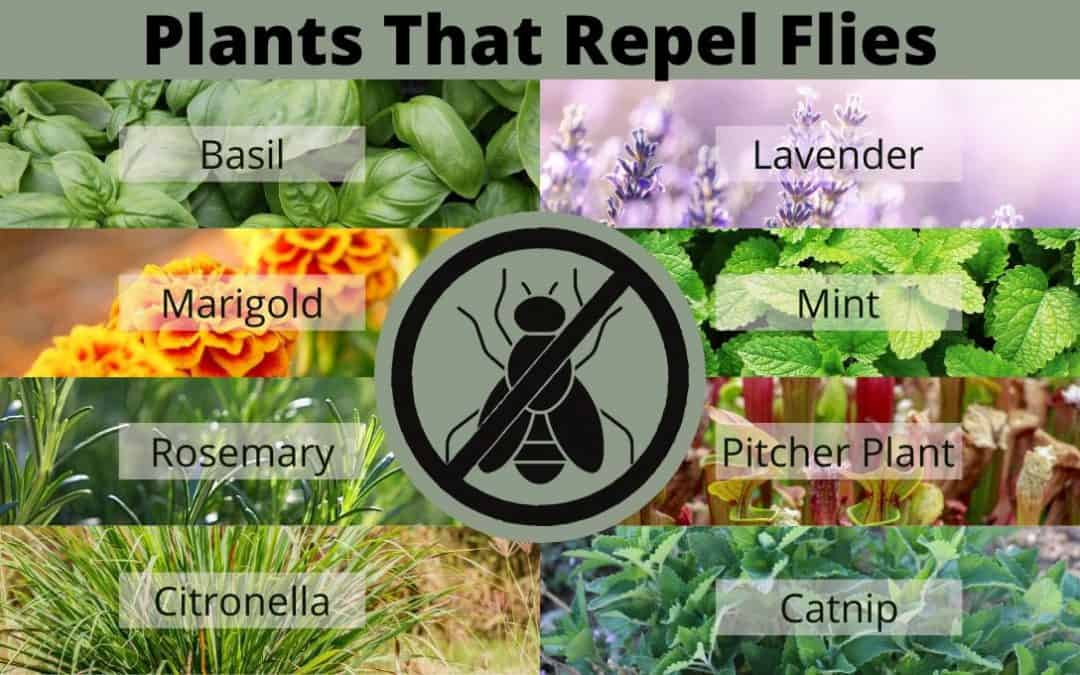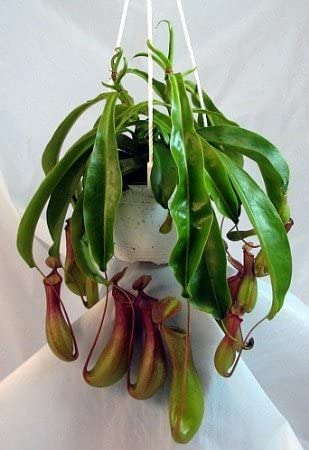Flies can be very annoying and they spread germs around…
Let’s take a look at some information and ideas on Plants That Repel Flies:
A single fly can keep you from enjoying an outdoor meal in your backyard. At times they even fly into the house (or underground lab 😆) and roam around. You’re there thinking, ‘if only there was something I could do to chase them away’. Well, the first option is to use chemical insecticides but these would harm any beneficial flies and other insects in your yard.
The best option is to use organic means for pest control. Instead of buying organic essential oils and other natural products though, planting fly repelling plants is a great idea for long-lasting repellent. They will repel flies and other annoying insects like mosquitoes, ticks, ants and fleas to name just a few. It will also confer all the other benefits offered by plants like filling your garden with the wonderful fragrance of fresh herbs.

Image found in Business Insider article on Breaking Bad’s fly episode
How does this work and what are some of the benefits you stand to gain? Some of these plants have strong fragrances that insects do not love. The flies would rather stay away from these pungent smells. Other plants have oils that are known to have insecticide-like actions. Some plants are even carnivorous and they will ingest any fly that rests on their leaves. Regardless of the mechanism, insect repelling plants provide many benefits. These include:
- Keeping insects away from the house and people.
- Beautifying the garden or house (if potted and placed inside).
- Sweet smelling yard.
- Some of these are edible too.
- Keep insects that affect crops away.
- Fresh air.
- All natural.
What Are The Best Herbs The Repel Flies?
How Basil (Ocimum basilicum) Repels Flies
Basil is a herb that will grow nicely in a pot or container garden. You can place the potted plant in any room or just outside the house. It will be a great aesthetic piece and will repel flies. It will repel mosquitoes and even spiders. It also keeps many other bugs away from nearby plants. Grow basil next to your roses or tomatoes and they will have a healthy life.
The basil plant is annual but if allowed to bloom it may reseed itself. To get more leaves, do not allow it to flower. Snip off stalks that are sending out flowers. This also helps it live longer. Fresh basil may be used to prepare an easy DIY insect repellent spray:
• Place fresh basil leaves in a container.
• Pour boiling water into the container.
• Let it steep for several hours.
• Remove the leaves and squeeze out all the water.
• Mix this with a little vodka (or Roc Vodka…last pop culture reference, I swear!!!) and you have a nice insect repellent spray.
• Apply the spray when going outdoors.
The basil plant is not only good for keeping flies away. It is also a tasty ingredient. You may use it to prepare salads and meals like Thai chicken and pork.
Lavender (Lavandula angustifolia)
The beautiful leaves will brighten up any garden. As for the sweet scents, lavender oil has been used to keep clothes smelling fresh well before the Tide Pod challenge came along (okay I lied!). Well, that nice scent is good for our noses, but both flies and their annoying cousins the fruit flies hate it. This is why a lavender plant will keep them at bay.
Lavender will do best in a place with lots of sunshine and well-drained soil. Wherever it is planted, it will repel flies, fleas, mosquitoes, moths and more. It will also give the patio area a nice fresh smell. When it flowers, the flowers may be cut off, dried and placed in packets. Store these packets in drawers and closets to keep crawling bugs at bay while giving your clothes a fresh smell. The culinary masters reading this article will be glad to know that lavender may be used in a wide variety of dishes. Dried leaves may be used in brewing tea, while fresh blossoms will make your desserts and sauces tastier.
Can you pot lavender? These plants grow to be big but with the following tips you can successfully plant potted lavender.
• Give it lots of light. If you do not have enough sun shining in, place a lamp nearby.
• Choose a place with good air flow.
• Ensure the soil in the pot is loose.
• Prune the plant in fall.
• When the plant gets too big, cut off a few pieces and plant in other pots. Keep the pots around the kitchen window and different parts of the home for a fresh lavender scent all around the house.
Rosemary (Salvia rosmarinus)
Known best for its amazing taste when added to food, rosemary serves more than culinary purposes. It has been used to cook a wide variety of dishes including, but not limited to, lamb and poultry dishes. The rosemary plant is also a decorative piece. It may be shaped into any shape and it will hold.
The sweet smell of rosemary is what makes it able to repel insects. Mosquitoes simply do not like it and neither do fruit flies. The insects will stay far from the plant and if it is in your compound there will be no bugging creepy-crawlies around. You can also cut sprigs of the rosemary and hang them around the house to repel bugs. Oil can also be extracted to prepare a spray bottle with insect repellents that can be applied on the skin to keep mosquitoes away. Just boil dried leaves and sieve, then keep the product refrigerated.
The rosemary plant is a demanding one. Taken care of, it will remain green all year round and will grow up to 5 feet tall. It may be grown outside on a patio or potted inside. What are the best conditions it needs to thrive?
• Good airflow.
• 6 to 8 hours of sunshine daily (keep potted plants near a window).
• Well-drained soil.
Mint (Mentha)
You must have found mint-flavored products in the supermarket on your last visit. Whether it is tea, bubblegum, a favorite drink or even air freshener, there are very many products flavored with mint oil. This one has an awesome taste that has been used in making various products and even in cooking. Mint leaves will add a nice flavor to any dish. The characteristic smell of all mints comes from a product called menthol which is present in almost all parts of the herb. There are various types of mint plants including peppermint and spearmint. Choose any kind and you will have fly-repelling plant in your home.
Plant mint in any part of the home that gets at least four hours of sunshine. Can it be potted? Yes, it can and should be potted. Grown in a garden, mint spreads very fast and will soon cover a large area. It is best to pot these plants and prune them often. Use the prunes to prepare mint-flavored tea and other delicacies.
To repel insects, mint leaves and stems may be used fresh, dried or their oil extracted to make repellent sprays. Pot a few plants and keep them in different parts of the home for a place free from mosquitoes and flies.
Marigolds (Tagetes)
Did you know that the flowers of marigold do not open in the morning if it is going to rain on that day? Cultivate some marigolds and find out how true this is. You will get many other benefits aside from the fragrance of beautiful flowers, including repelling pests and bugs. This plant has been proven to be effective against whiteflies that usually affect tomatoes. It releases a chemical known as limonene that slows these flies down. Marigolds’ roots repel nematodes which keeps your vegetable garden healthy. Grow them interspersed with your vegetable crop and you will see a difference in your harvest. Marigolds also repel pests like aphids, insects like mosquitoes and big animals like rabbits.
There are many varieties of marigold but they all confer the same benefit which is to repel unwanted bugs. Marigolds do well when grown outside on the garden or patio. They need full sun and well-drained soils although you do not need to keep the soil moist at all times. In order to reap maximum benefits from marigolds, grow them near:
• Tomatoes
• Roses
• Legumes
• Other vegetables.
Catnip (Nepeta cataria)
This is one of the herbs that humans grow but do not normally eat. However, it can be used to make herbal teas. If you have a cat, this plant is the perfect gift. Cats love it so much and you will find them licking it, rubbing it and even chewing a leaf. Actually, the natural love cats have for these herbs is the reason for their naming. On the other hand, flies and mosquitoes are repelled by this plant. It contains a very powerful insect repellent chemical known as nepetalactone. Even mice do not like the scent of the catnip and will stay away. After all, where there are cats, rats keep off!
If well taken care of, a catnip can grow up to four feet tall. In early summer, it will give beautiful purple flowers that will brighten up your garden or home. This plant may be planted in the garden or potted. Care should be taken to prevent it from occupying a large space as it spreads fast.
What are the favorable growing conditions for catnip? (other than keeping the cat away!)
• Water to keep the soil moist.
• Partial to full sun.
• Alkaline soil.
Sage (Salvia officinalis)
This perennial plant may be grown in pots or directly on land. It gives leaves that have a pungent smell and these have been previously used in cooking pork, poultry and flavoring many other foods. There are various types of sage but they will all generally make a bug vacate the patio area. The wild sage (Lantana) has been proven to repel malaria-causing mosquitoes.
Bees and butterflies love the colorful flowers sage gives but flies and other pests do not. This is why sage is able to repel them. Plant it near the house and bugs will no longer bug you. You can also make an insect repellent spray from this plant’s leaves.
Citronella Grass (Cymbopogon nardus)
This is a kind of grass that will do more than beautify your lawn. It will keep flies, ants, deer-ticks, mosquitoes and other bugs away. Citronella is part of the lemon grass family made up of plants that have a lemony taste that is used to flavor many foods and beverages. It is an aromatic grass containing citronella oil that repels insects and keeps them away from the home. Applied on the skin, it will act as a repellent so you can avoid those nasty insect bites and the ugly marks that come afterwards.
What do you need to grow citronella grass effectively?
• Warm climate wit full sunshine.
• Well-drained soil.
• Frequent watering.
The Pitcher Plant (Sarraceniaceae family)
Unlike any other on this list, these plants are carnivorous just like the Venus Flytrap that fascinated you in elementary school. They lure an insect to land on their leaves using scents, nectar and colors. Once the insect stands on a leaf, the plant ingests it. The pitchers on these plants have characteristics that make it possible for them to trap insects.
• The inside area is slippery.
• The hairs face downwards.
• Funnel-shaped
There are several kinds of pitcher plants and you can get one that you like the most. It will ingest ants, slugs, snails, wasps, flies and other insects that get to the pitcher. In order to obtain proper growth, keep pitcher plants in moist and sunny areas.
Why do pitcher plants “eat” insects? Simply put, it is nature. They are able to obtain the nutrients other plants do using roots from the insects they ingest. You should not feel bad for the insects. Remember that the wild world is about predator and prey. Honey badger don’t care… Let nature take her course. She’s savage AF!
The Bottom Line: What Fertilizer-For-Less Says on Fly Repelling
Which of the above plants that get rid of flies should you cultivate? You can plant any that you like or combine several for the best results. The herbs are particularly a great choice because they get rid of bugs and are used as tasty ingredients in cooking. Whichever you choose, ensure that you give the plant the right conditions for growth. You will be able to get rid of flies without using any chemicals. As a bonus to you for reading the full article, we added a few more shrubs, bushes, flowers and herbs below that may also work around your yard:
Hardy chrysanthemums | Pennyroyal | Nasturtiums | Petunias | Floss flowers | Bay leaves | Chives | Garlic








